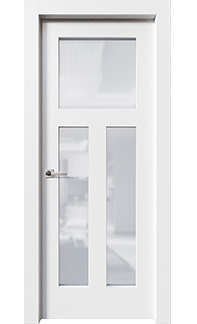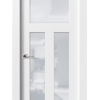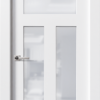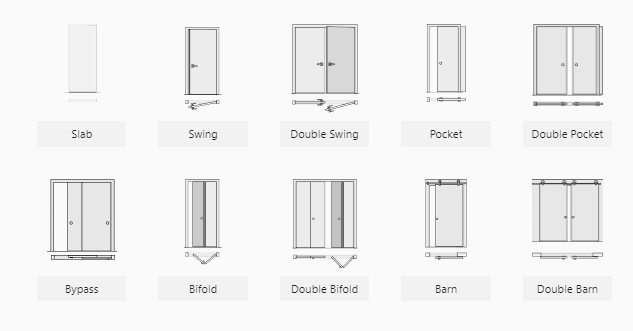Description
THE DOOR NAME ORIGIN – “SHAKER STYLE 3 CRAFT LIGHT LAMI GLASS”
This interior door is similar to its 3-panel Craft counterpart in the series except for the 3 lami glass lights replacing the 3 panels.
The sentiment is largely the same, though. The design was inspired by the Shaker movement in particular, which was, when all is said and done, New England’s answer to “new luxury.”
Two revolutions – American and French – effectively ended the final stage of the Baroque period known for its rococo extravagance. The income gap began to shrink, the middle class finally came into its own, and urban architecture began to take into consideration, not just the needs of the aristocracy, but those of other people as well. The face of every major city on the planet started to change. Whereas in the past a city was an area with a few landmarks (churches and palaces, mostly) surrounded by largely unattractive make-shift housing cobbled together every which way, the new construction wave brought the Neoclassical residential building to the scene. Elegant paved streets and avenues appeared with structures of brick and limestone. Gas light and soon after electricity illuminated civic centers at night. Before long, however, the new wealthy class of industrialists found that the royal luxury of old wasn’t all bad after all.
Baroque themes began to reappear in urban and countryside architecture little by little. The Shakers would have none of it. A style was invented whose purpose was to keep the elegance while eschewing all excess.
Lest we forget: as all Almes Doors, this interior door does come with all the usual great hardware features.
(It is worth noting that the Shaker culture encouraged and promoted its innovators. Sarah “Tabitha” Babbitt, one of the original American Shakers, is credited with the invention of the first circular saw (for use in a saw mill; this was in the year 1813. The cut nail is often ascribed to her as well).
It started with furniture, but soon elements of the Shaker style were found in other design elements (including, of course, interior doors). Craftsmen advocating the new approach traveled beyond New England, and soon the Shaker style was gaining popularity across the entire continent.
One of the intriguing design features of this particular interior door – a “craft” item – is that, because of its elegant simplicity, it can fit seamlessly into any type of decor, contemporary or traditional without losing any of its character.
The Italian-made 3D-adjustable concealed hinges will make installation easy and quick, as well as add to the overall elegance of this product. The soundless magnetic lock is known for its dependability. The automatic sweep enhances the wonderful sound-proofing and thermal insulation qualities, which is to say it will ensure privacy as well as significantly reduce your electrical bill.
… Fair is fair. The Shaker movement did appear in Eighteenth Century England first. Even back then, they already espoused egalitarian ideals, with women taking on spiritual leadership roles alongside men. That said, the first furniture (and interior door) designers came from New Lebanon, New York. Next time you’re up there, it might be a good idea to examine what still remains of their architecture (including, of course, the interior doors).
FINISH: WHITE
This is a bit tricky. Isn’t White the default finish that would look great on any interior door? Well, not quite.
W. is the color most often associated with perfection, honesty, cleanliness, newness, neutrality, and exactitude. The pigment has been known and used by humans since prehistoric times. In ancient Egypt, W. symbolized purity. Roman patricians paraded around in W. togas to distinguish themselves from the common folk. It was the color of choice of French monarchs. Architects of all epochs used W., with considerable enthusiasm, in various projects and for various reasons. In the United States, architects favored it when designing churches, capitols, and municipal buildings – which is, in fact, a tradition they inherited from classical and Renaissance architecture. According to some experts, most of the buildings in the celebrated Forum were either made of, or clad in, W. marble. In Taoism, it represents the yang or masculine energy, one of the two complementary natures of the universe. Many authors, both classical and contemporary, have referred to W. as a sign of purity, either physical (like William Shakespeare, whose treacherous usurper monarch wishes a heavenly rain would cleanse his blood-stained hand, washing it “white as snow”) or spiritual (like Tennessee Williams, who named his lead character Blanche (derived, incidentally, from the Germanic word blanc)) as a symbol of her innocent child-like spirit, perceptible from the moment she makes her first entrance (through the interior door stage-left).
Back in the Seventeenth Century, Sir Isaac Newton discovered that sunlight is composed of light with wavelengths across the visible spectrum which the human eye perceives as W. It is the lightest of the spectrum, and achromatic (hue-less) to boot, because it fully reflects and scatters all visible wavelengths of light, absorbing none. W. objects stand out in the dark. Depending on the surroundings, an interior door with W. finish might come off as emphatic or tactful, dominant or complementary. It blends seamlessly into most types of decor and, once the owner’s needs and disposition are taken into account, can symbolize – oh, so many different things, while bringing back a myriad memories: from those glorious snowy Alpine slopes and peaks to the fluffy tops of the wayward herd of cumulus cloud heap over the horizon on a balmy afternoon in the Caribbean. Tropical sand beaches are W. due to the high quantity of calcium carbonate they get from tiny bits of seashells ground to powder by the waves. In a number of cultures W. can also symbolize festivity, and be used lavishly to brighten up weddings, birthdays, and anniversaries. It is beautiful. Make sure it goes well with your interior door model, though.










